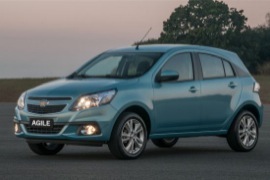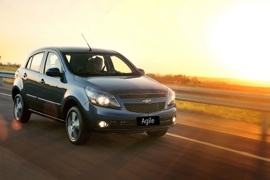CHEVROLET Agile Models/Series Timeline, Specifications & Photos
First production year: 2009
Engines: Ethanol, Gasoline
Body style: Hatchback
Chevrolet introduced a facelifted version for the Agile super-mini model in 2013 and updated its look and safety features for specific trim levels.
When GM needed a new super-mini vehicle for the South American market, GM Brazil was in charge of making it happened. Thus, the engineers took the Opel/Vauxhall Corsa D platform and transformed it into a Chevrolet. Since there were just a few mandatory safety rules, they stripped the car from ABS and airbags, and that resulted in very poor results on the Latin NCAP test. In 2013, Chevrolet updated the model.
At the front, the car sported a smaller grille than before. It still had the same horizontal slat that supported the bow-tie badge, but it was shorter than before. The restyling led to a new front bumper where the carmaker installed bigger fog lights. The headlights were fresh as well. On the C-pillars, Chevrolet designers imagined a new line that made a floating-roof styling in the back. A new set of taillights flanked the tailgate while the bumper was reshaped and sported two additional red-reflecting spots on the sides.
Inside, the carmaker reimagined the interior. Apart from the driver's seat, all others could have been folded down to increase the transport area. GM installed a new seat for the driver with a new height adjustment system. There was also a new steering wheel with an airbag. For the LTZ trim level, Chevrolet installed standard ABS, while for the rest of the range was optional.
Under the hood, GM kept the same 1.4-liter flex-fuel engine, which could run on gasoline and ethanol as well. The Agile featured a five-speed manual fitted as standard, while an automated five-speed was on the options list.
General Motors' presence in South America was important for the American automaker, and the Agile was built for those looking for an affordable, cheap-to-run vehicle.
During the world financial crisis of 2008 – 2010, GM struggled to get more money from the market with minimal investments. So, all it had to do was to grab an already developed platform, make it look like a different car, and call it a day. As a result, it took a European Opel Corsa D, modified it, adapted it to local specifics, and sold it. It was the most basic car on the South American market in its segment and was considered unsafe by the Latin NCAP since it didn't have an airbag or ABS. Still, the car sold well since it offered the minimal requirements for a family hatchback.
Despite the vehicle's small size, the automaker installed a pair of big headlights similar to those from the 2008 Chevrolet Cruze. Furthermore, the grille seemed oversized, with its trapezoidal shape crossed by a horizontal slat where the bow-tie badge took center stage. On the lower bumper, the automaker placed an additional broad air intake crossed by a horizontal slat and flanked by optional round fog lamps in separate clusters.
From its profile, the little Agile revealed its connection with the European Opel/Vauxhall Corsa due to its arched roof line. Furthermore, the short overhangs and tall greenhouse were typical for a vehicle built mostly for city usage. Still, since the Agile was built to cope with low-quality roads, it featured a higher ground clearance than its Corsa sibling. At the back, Chevrolet's styling team created a floating-roof design theme on the C-pillar by following the descending window line with a black element. Finally, the car sported clear taillights on the rear fascia that flanked the wide-opened tailgate.
Chevrolet made the Agile in three trim levels: LS, LT, and LTZ. The LS was unavailable in all markets, while the latter two were the most commonly ordered by customers. One of the most significant upgrades over its Corsa sibling was on the dashboard design, where the Agile got an angular-shaped binnacle instead of a rounded one. Inside it, the automaker placed the instrument panel with a wide speedometer on the left while the tachometer and the fuel-level gauge occupied the right side. An additional LCD between the dials showed additional information from the car's onboard computer. The front seats were adequate for adult-sized occupants, but the split-folding rear bench seat was barely suitable for more than three grown-ups.
Even if the base model of the Agile came without ABS or Airbag, customers could opt to get them on the LTZ trim level. Furthermore, that version was also available with an automated gearbox (single-clutch automatic) carried over from the European model. Chevrolet installed a 1.4-liter engine in the Agile that was available either with gasoline or ethanol fuel.

